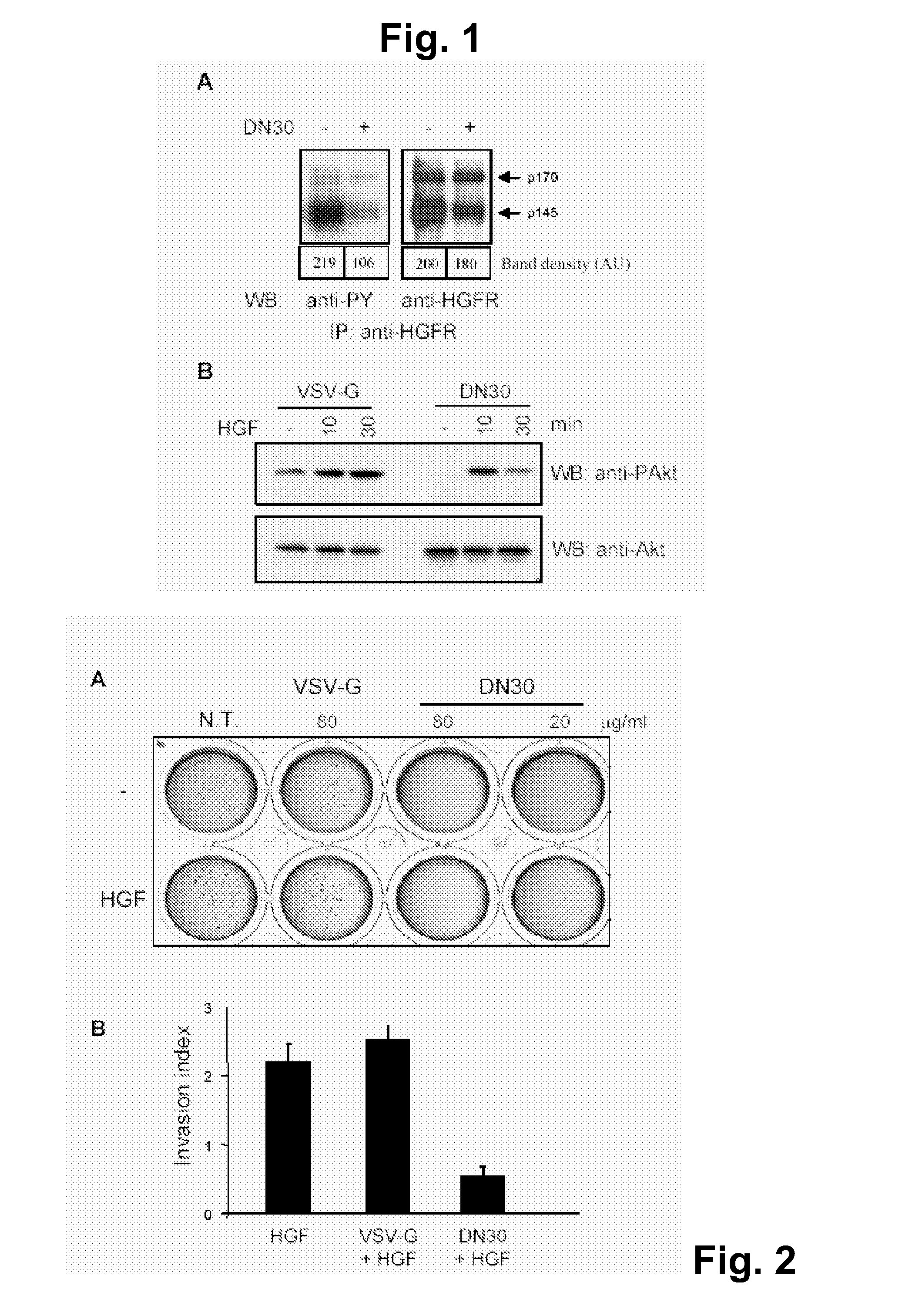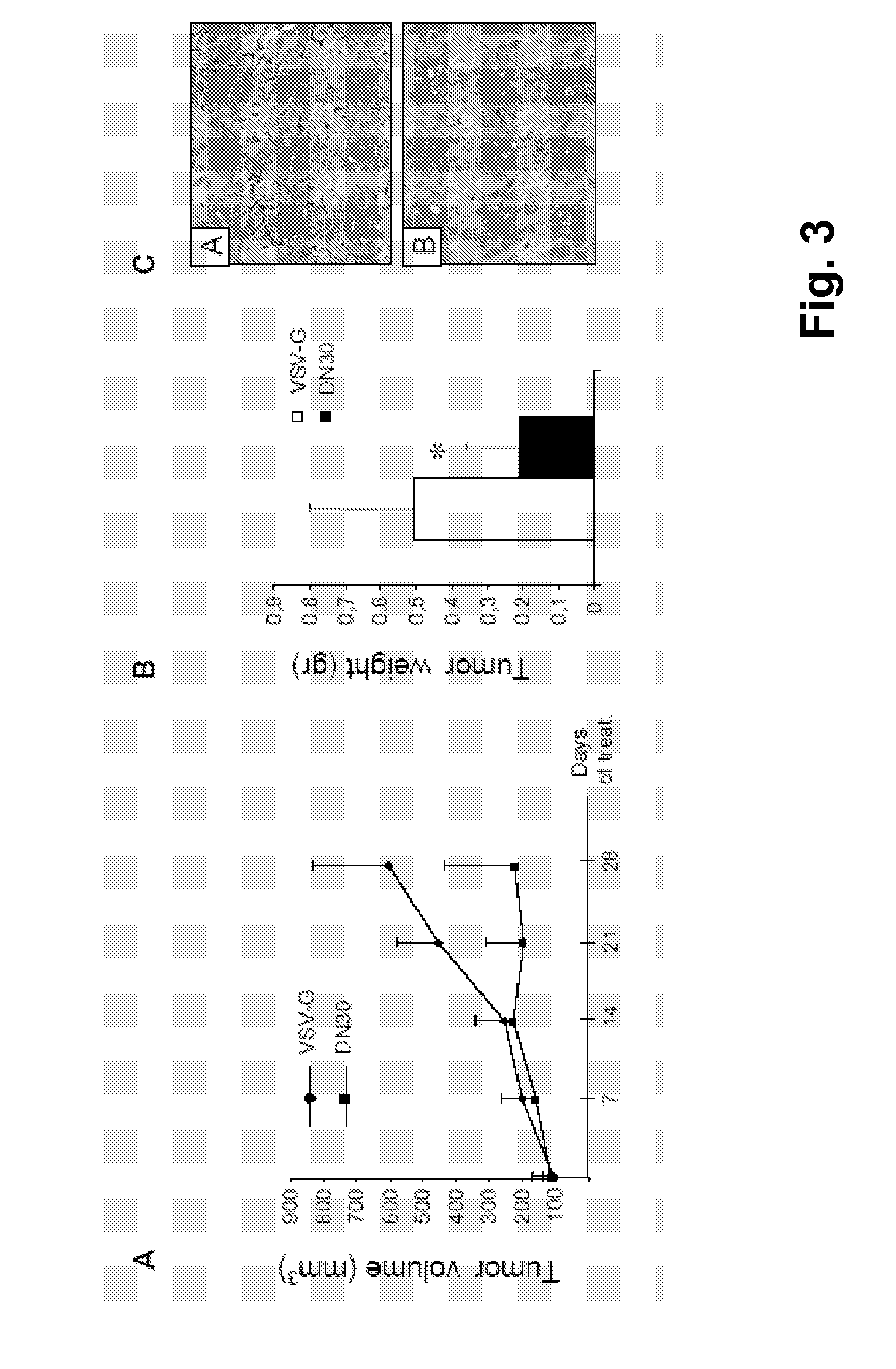Anti-Met Monoclonal Antibody, Fragments and Vectors Thereof, for the Treatment of Tumors and Corresponding Products
a monoclonal antibody and tumor technology, applied in the field of monoclonal antibodies, can solve the problems of poor understanding and become a challenging approach to hamper the tumorigenic and metastatic processes
- Summary
- Abstract
- Description
- Claims
- Application Information
AI Technical Summary
Benefits of technology
Problems solved by technology
Method used
Image
Examples
example 1
The Anti-Met Antibody AntiMET-R Impairs HGFR Signal Transduction
[0084]AntiMET-R is a monoclonal antibody directed against the extracellular domain of HGF receptor where it recognizes an epitope distinct from that bound by the ligand. This mAb behaves as a partial agonist, since it does not trigger all the biological effects elicited by hepatocyte growth factor (motility, proliferation, cell survival, invasion, tubulogenesis and angiogenesis) but it induces only motility. Moreover, it up-regulates the constitutive expression of urokinase-type plasminogen activator but it is not able to induce and sustain the expression of urokinase-type plasminogen activator receptor for prolonged periods of time. This mAb activates receptor phosphorylation, which, being strictly dependent on mAb bivalence, requires receptor dimerization.
[0085]To address the question of whether the AntiMET-R antibody might represent a tool to interfere with constitutive HGF receptor activation in over-expressing tumo...
example 2
AntiMET-R Inhibits the Transformed Phenotype of Cancer Cells In Vitro
[0088]The effect of the antibody on cell growth and on the transformed phenotype was assessed by measuring the ability of cells to grow in anchorage-dependent and -independent manner and to invade extra-cellular matrices. As shown in FIG. 2A, no difference in the ability of cells to grow in conditions of anchorage dependency was observed upon antibody treatment.
[0089]Anchorage-independent growth is strictly dependent on the ability of cells to overcome apoptosis due to lack of anchorage, the so-called “anoikis”; this property is usually analysed by evaluating the capability of cells to grow in soft agar (28). Since many reports have shown that HGFR activation is able to confer to cells this property, the inventors seeded GTL16 cells in 0.5% agar and maintained the culture in the presence or absence of different amounts of AntiMET-R or of an irrelevant isotype-matched antibody (VSV-G), as a control. As shown in FIG....
example 3
AntiMET-R Inhibits the Transformed Phenotype In Vivo
[0091]To assess the activity of AntiMET-R on tumor growth in vivo, the inventors inoculated subcutaneously GTL16 cells into the posterior flank of immunodeficient nu / nu female mice. The animals were treated twice a week with either AntiMET-R or VSV-G, administered in situ (2 μg / gr). The therapy started 1 week after transplantation, upon appearance of tumors in the site of injection: only animals bearing tumors of comparable size were treated for 4 weeks. Tumor volume was monitored during all treatment and a decreased growth was observed in AntiMET-R treated mice (FIG. 3A), After treatment, mice were autopsied and tumors were excised and weighed. As shown in FIG. 3B, in mice treated with AntiMET-R, tumors were significantly smaller than in controls (p<0.05). In these tumors the level of HGFR activation, shown by staining with specific antibodies against the phosphorylated form of the receptor, was decreased (FIG. 3C) while the perce...
PUM
| Property | Measurement | Unit |
|---|---|---|
| Solubility (mass) | aaaaa | aaaaa |
| Fluorescence | aaaaa | aaaaa |
Abstract
Description
Claims
Application Information
 Login to View More
Login to View More - R&D
- Intellectual Property
- Life Sciences
- Materials
- Tech Scout
- Unparalleled Data Quality
- Higher Quality Content
- 60% Fewer Hallucinations
Browse by: Latest US Patents, China's latest patents, Technical Efficacy Thesaurus, Application Domain, Technology Topic, Popular Technical Reports.
© 2025 PatSnap. All rights reserved.Legal|Privacy policy|Modern Slavery Act Transparency Statement|Sitemap|About US| Contact US: help@patsnap.com



